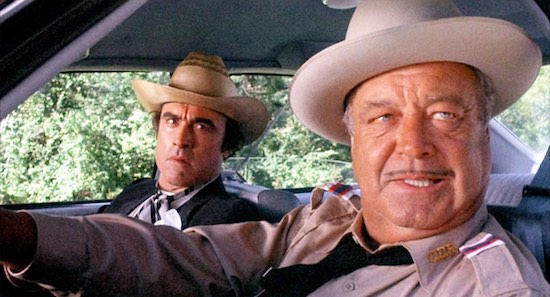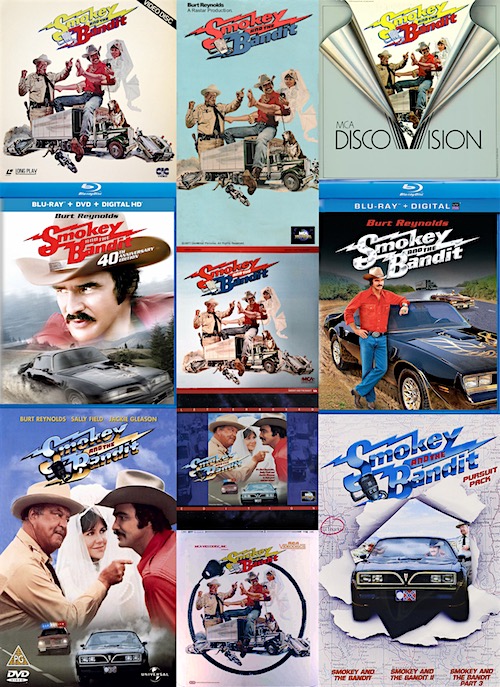
THE Q&A
Lee Pfeiffer is the Editor-in-Chief of Cinema Retro magazine, which celebrates films of the 1960s and 1970s and is “the Essential Guide to Cult and Classic Movies.” He is the author (with Philip Lisa) of The Incredible World of 007: An Authorized Celebration of James Bond (Citadel, 1992) and The Films of Sean Connery (Citadel, 2001), and (with Dave Worrall) The Essential Bond: The Authorized Guide to the World of 007 (Boxtree, 1998/Harper Collins, 1999). He also wrote (with Michael Lewis) The Films of Harrison Ford (Citadel, 2002) and (with Dave Worrall) The Great Fox War Movies (20th Century Fox Home Entertainment, 2006).

---
Michael Coate (The Digital Bits): In what way should Smokey and the Bandit be remembered on its 40th anniversary?
Lee Pfeiffer: The film spoke to a certain demographic — people who lived in rural America — in a way that Hollywood productions of the era rarely succeeded in doing. There was a time when studios courted this market specifically by churning out low-budget action movies, Westerns, comedies and exploitation films but as audiences became more demanding in their tastes, public sentiment switched to glossier productions. Indeed, as far back as 1935, Variety ran a famous headline “Hix Nix Stix Pix,” meaning that films that were specifically targeted for rural audiences were being ignored in favor of big movies with big stars. The success of Smokey reawakened studio interest in producing films targeted to people who didn’t live in major urban areas. It was a film that boasted big stars and good production values. Rural audiences felt the movie spoke to them in a way that wasn’t condescending or insulting in the manner that previous attempts to reach their wallets were. Burt Reynolds was riding high at the time. Along with Clint Eastwood, he was arguably the biggest star in the world so the movie’s success didn’t surprise anyone. What did surprise studios was the extent to which it was embraced by rural audiences. The movie played seemingly forever in some theaters in the south and the heartland. It proved to Hollywood that there was plenty of profit movies that spoke to folks who still saw first run movies in drive-in theaters.
Coate: What do you think of Smokey and the Bandit? Can you recall your reaction to the first time you saw it?
Pfeiffer: I think I saw it back in college when I went to a screening to review the film for the campus newspaper. I didn’t like it very much then and probably wouldn’t care for it very much now, though I’ll confess I haven’t seen it in many years. I always liked the work of Burt Reynolds and Sally Field and Jackie Gleason is one of my idols. But I just couldn’t relate to the humor the way some people did. I think it’s really a matter of demographics, specifically where you live. I’m a big city person who grew up with New York City just across the river, so Manhattan was my “playground,” if you will — and still is. Thus, I always related more to Woody Allen comedies than the kind of humor presented in Smokey and the Bandit. That’s not meant to be a knock on the film. I once wrote a book about classic movies and I think I included Smokey in it. My editor was aghast but left it in because I argued that, for the purposes of that specific book, I defined “classic” as any film that had a highly enduring legacy in regard to its intended audience. Smokey wasn’t made to please people who frequent cafes on the East Side of Manhattan. It was made for audiences who could relate to the kinds of eccentric characters you find in small town America in much the same way that Scorsese is able to do the same with characters you find in urban settings. I respect Smokey for its durability. People who loved it back in the day still love it today.
Coate: What did Smokey and the Bandit contribute to 1970s Cinema?
Pfeiffer: The film proved that not every major hit had to be a mega-budget blockbuster. Even by 1977, studios were becoming increasingly reliant on spectacle and special effects. That year alone saw the release of three major hits that relied heavily on technology: Star Wars, Close Encounters of the Third Kind and The Spy Who Loved Me — all fine movies but ones that continued to convince studios that bigger was always better. Smokey reminded them that a film on a fairly modest budget with popular stars could still draw big audiences. Don’t forget there was no cable TV in those days and home video was just in its infancy. The average person could only see a favorite movie again by going to a theater. Smokey played for many weeks, packing in audiences — and then would be revived by popular demand in small town theaters. That type of pattern doesn’t happen today. Even if a movie is a blockbuster, it generally clears out of theaters quickly so the studio can capitalize on the home video and cable sales.
Coate: Where do you think Smokey and the Bandit ranks among director Hal Needham’s body of work?
Pfeiffer: Well, Needham’s “body of work” is pretty thin as director. He was one of the very top stuntmen and stunt coordinators in the business and that is his real legacy. He gravitated to directing because he had worked on so many films he probably felt he could direct one in his sleep. He was also a personal friend of Burt Reynolds and had worked as a second unit director on some of his earlier films. Reynolds’ clout got him the directing gig on Smokey and Needham came through for the studio. However, his career as a director was largely linked to Reynolds’ popularity. They went on to make one good movie together — Hooper — and a couple of dogs that still made a lot of money: The Cannonball Run and Smokey and the Bandit II. He made a couple of other films without Reynolds but they are largely forgotten. He and Reynolds reunited in 1984 for Cannonball Run II but the bloom was already off the rose and the movie didn’t perform very well. Within a couple of years, Needham wasn’t directing any major films. However, it should be acknowledged that the man knew his limitations and stayed within his comfort zone. His films generally contained elaborate stunts and car chases, which were challenges he knew he could always rise to. The fact that we are still talking about Smokey and the Bandit forty years later is probably the greatest testament to his talents.
Coate: Where do you think Smokey and the Bandit ranks among Burt Reynolds’, Sally Field’s and Jackie Gleason’s bodies of work?
Pfeiffer: That’s a pretty subjective question because, in terms of popularity, it probably represents the pinnacle of Burt Reynolds’ career. However, it also laid the groundwork for his rather rapid demise in terms of his box office appeal. As Reynolds himself acknowledged, he began to rely too much on the low-hanging fruit of good ol’ boy country comedies. Clint Eastwood did two such films, co-starring with an orangutan and they were both hits — but he knew when to walk away from the genre. Reynolds didn’t. When he turned down the role that won Jack Nicholson an Oscar for Terms of Endearment in order to do Stroker Ace with Hal Needham, his career was irreparably damaged. In terms of Reynolds’ achievement as a personality, Smokey was a triumph for him because it epitomized how audiences wanted to see him — as the over-sexed, towel-snapping prankster and man of action. In terms of Reynolds’ “serious” efforts, however, I think his star-making dramatic performance in Deliverance is his most impressive work.
For Sally Field, who was romantically involved with Reynolds at the time, this was nothing more than a fun outing. She always had a talent for light comedy and had become a star on the sitcoms Gidget and The Flying Nun, so this was probably nothing more than a pleasant paid holiday for her.
For Jackie Gleason the film was more important. He was one of the most iconic of American comedy stars but his legacy was in danger of being overlooked by younger audiences who only knew him as Ralph Kramden from the eternal comedy series The Honeymooners. Gleason stole the show as Sheriff Buford T. Justice and found a whole new audience, proving he still had his mojo. It was the biggest hit of his career, even if the character was, shall we say “inspired” (aka “ripped off”) from the almost identical Sheriff J.W. Pepper played by Clifton James a few years earlier in the James Bond films Live and Let Die and The Man with the Golden Gun. Gleason was also an outstanding dramatic actor but he rarely got a chance to show off these talents. For the best dramatic work of his career, just watch him as pool hustler Minnesota Fats in the 1961 film The Hustler. He’s only on screen for a limited time yet he got an Oscar nomination. He was also outstanding as a corrupt boxing manager in the big screen version of Requiem for a Heavyweight. However, he will always be immortalized for The Honeymooners. Even kids today seem to be familiar with the show and sixty years later, it’s still being shown on Saturday nights on New York television.
Coate: What is the legacy of Smokey and the Bandit?
Pfeiffer: Smokey proved to studios that there was still “gold in them thar hills,” to coin the old phrase, when it came to appealing to rural audiences which had often been neglected especially in the era in which the Western movie genre went into a decline. It also boasted something that is lacking today: genuine star power. There are very few real movie stars left today. By that I don’t mean recognizable names or people who command big salaries. “Stars” were people whose movies would generate profits simply by their presence in them. Back in 1977, Reynolds, Field and Gleason were very popular screen presences and represented movie stars in the classic sense of the term. It’s hard to think of many stars today — people who draw in big audiences regardless of the genre of film and perhaps in spite of bad reviews. Smokey also represented a time in which families felt comfortable going to movies together and not having to cringe at the elements of sex and violence. Smokey never went beyond some naughty jokes and double-entendres and the violence was cartoon-like because no one ever got hurt. I still can’t say I’m a fan of the movie but for the reasons I’ve outlined in this [interview], I have a lot of respect for it.
Coate: Thank you, Lee, for participating and for sharing your thoughts on Smokey and the Bandit on the occasion of its 40th anniversary.
--END--
All figures and data included in this article pertain to the United States and Canada except where stated otherwise.
IMAGES
Selected images copyright/courtesy Rastar, Universal Pictures, Universal Pictures Home Entertainment
SOURCES/REFERENCES
The primary references for this project were regional newspaper coverage and film reviews, and trade reports published in the periodicals Boxoffice, The Hollywood Reporter and Variety.
SPECIAL THANKS
Al Alvarez, Nancy Arn, Kim Averette, Laura Baas, Don Beelik, Kevin Blinn, Louis Bornwasser, Laura Calderone, Margaret Carter, Kevin Chatham, Tom Cole, Saundra R. Cropps, Robert Cruthirds, Laura Fazekas, Jesse Gibson, Khalilah Y. Hayes, Mike Heenan, Beatheia Jackson, Sarah Kenyon, Joanne Lammers, Ronald A. Lee, Mark Lensenmayer, Karin Lindemann, Stan Malone, Michael Mitchell, Sana Moulder, Vivian R. Osborne, Stuart Parks II, Lee Pfeiffer, Roxanne Puder, Dalton Royer, Cliff Stephenson, John Stewart, Sean Sutcliffe, and to all of the librarians who helped with the research for this project, and to the Academy of Motion Picture Arts and Sciences’ Margaret Herrick Library and Fairbanks Center for Motion Picture Study.
IN MEMORIAM
Bill Justis (Music), 1926-1982
Jackie Gleason (“Sheriff Buford T. Justice”), 1916-1987
Angelo Ross (Editor), 1911-1989
James Lee Barrett (Screenwriter), 1929-1989
Walter Hannemann (Editor), 1912-2001
Anthony Magro (Sound Editor), 1923-2004
Pat McCormick (“Big Enos”), 1927-2005
Macon McCalman (“Mr. B”), 1932-2005
Jerry Reed (“Cledus”; Music), 1937-2008
Hal Needham (Director), 1931-2013
Ray West (Sound), 1925-2016
-Michael Coate
Michael Coate can be reached via e-mail through this link. (You can also follow Michael on social media at these links: Twitter and Facebook)





